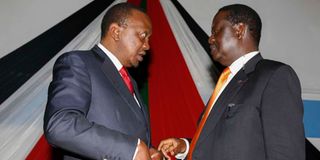Political pact heralds national unity dawn

Uhuru Kenyatta and Raila Odinga.
Ever since the country’s return to multi-party rule in 1992, the growth and sustainability of political parties has been a daunting task for politicians. Parties have often emerged and morphed into others through mergers and alliances, which has, inevitably, affected their longevity.
Many have endured a short lifespan, resulting in premature ‘death’. This has marked our history for most of the country’s political parties as they have only been viewed as vehicles for elections and as political shelters.
Few of the parties, however, are driven by political ideologies that stand the test of time. The situation is different from, say, Chama Cha Mapinduzi (CCM) in neighbouring Tanzania, whose political bent is centre-left to left from a historical left to far-left.
After Liberia’s True Whig Party, CCM is the second-longest-ruling party in Africa. It was formed in 1977. Kenya African National Union (Kanu) ruled for nearly 40 years. Despite losing its prominence and influence since its rout in 2002, and enduring a long period of turbulence, Kenya’s oldest party has managed to remain as one outfit and is now progressively resuscitating its influence.
Popularity
Orange Democratic Movement (ODM) has also maintained a positive growth curve as far as its popularity, influence and dominance is concerned. The party, led by veteran opposition icon Raila Odinga, has clout, with support from almost every region.
It could be for this reason that Jubilee Party, which President Kenyatta leads, wants to forge an alliance with it. The ongoing consultations are likely to lead to the formation of one of the greatest alliances ever between a ruling party and the second most powerful party in the country, especially after the closely fought 2017 elections.
A Jubilee-ODM coalition pact is a great opportunity for national unity. ODM was birthed from a popular grassroots movement in 2005 as a result of the 2005 constitutional referendum campaigns as a refuge for voters in informal settlements.
ODM has since morphed into a more nationalistic party, becoming a premier factor in at least three elections and two plebiscites. It’s the longest lasting of the big parties since the historic return of multipartyism in 1992.
As we await the events to unfold, maturity in our democracy is, at times, depicted through the altruistic nature of our leaders and their ability to unite beyond past squabbles and personal vendetta against political foes, the ability to rise above themselves and unite for the sake of the country’s future.
The road to a Jubilee-ODM coalition is proof of lasting peace premised on the 2018 ‘Handshake’ between President Kenyatta and Mr Odinga. The deal would be a huge boost to Jubilee electoral networks, creating the gateway for an elaborate Uhuru Succession matrix, whose foundations are to unify the country.
Selina Chiteri, Nairobi





